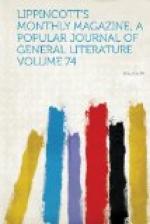Browne mixes in two more scenes before lunch. In the afternoon there’s a balloon ascension, where everything goes up but the balloon; and a croquet-party brim full of eccentricities. Browne picks up half a dozen juvenile and domestic incidents, hardly worth alluding to, and goes home, through a series of adventures, to find a tall, raw-boned horse, a total stranger, walking over his flower-beds and occasionally looking in at the windows. Browne’s skirmishes around the animal (the whole campaign together) cost him about thirty dollars.
I resign Danbury to Browne. Though there’s a capital fellow there whom I should like to see, I’d rather not go down there and pay taxes.
SARSFIELD YOUNG.
ANOTHER GHOST.
In the August number of this magazine a narrative is given of a ghostly appearance which haunted a house in a seaside town. The writer states that she was not an actor in its scenes, nor was it related to her by one who was. Having more than once heard the story from the lips of the principal witness of the events, Mrs. M—— of Newport, I can confirm the correctness of the narrative, in the main. Some of the particulars, however, having been altered in the transmission, I will give my version, to the best of my remembrance.
When Mrs. M—— hired the house, which had been for some time vacant, she found it difficult to procure or keep servants. This in itself is not uncommon, but in this case there was something more. The servants complained of being disturbed at night by a woman who walked the chambers with a white hood upon her head—not a sun-bonnet, as I am glad to state, which is certainly a more commonplace head-dress. Some of the neighbors were also asking from time to time who that woman was who sat at the upper hall window in a white hood. It could not have been a little boy who was disturbed by the strange woman, for Mrs. M—— had no son, but one of the daughters when sitting in the upper hall on a hot evening, and making the remark that it was very warm, heard the reply from out of the darkness, “I am so cold!”
As in Mrs. Hooper’s version, the denoument was brought about by the aid of a clergyman. Men of this profession have always been considered the most efficient guardians against the powers of darkness. He, with the help of Mrs. M——, made the excavation in the cellar which brought to light the half-consumed skeleton. Here, unfortunately, is a gap in the evidence. The remains were pronounced by medical authority to be human, but was that authority reliable? was that doctor skilled in comparative anatomy? If not, the bones might have been those of a sheep, buried perchance in the cellar by a provident dog.
The house still stands, or did recently, in Washington street. The builder was a sea-captain returning after a long absence with plenty of money, supposed by the townspeople to have been acquired in the slave-trade or by piracy. There was also a young woman, house-keeper to this Captain Kidd, who disappeared about the time that he did himself.




